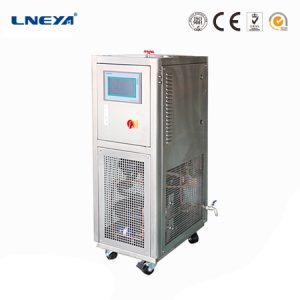Product Features of Fluid Heat Transfer Temperature Control System
The fluid heat transfer temperature control system is the refrigeration and heating device of the matching reactor reactor in the pharmaceutical chemical industry. So, what are the characteristics of the fluid heat transfer temperature control system in the process of use?

1. The fluid heat transfer temperature control system adopts a fully enclosed pipeline design and an effective plate heat exchanger, which reduces the demand for heat transfer fluid and improves the heat utilization rate of the system to achieve rapid temperature rise and fall.
2. The heat transfer medium is in a closed system with an expansion vessel. The heat transfer medium in the expansion vessel does not participate in the circulation. Whether it is high temperature or low temperature, the temperature of the expansion tank is from room temperature to 60°C, which can reduce the absorption of water and heat by the heat transfer medium during operation. Risk of volatilization.
3. The successful development of the fluid heat transfer temperature control system has greatly reduced the operating costs required for independent temperature control of the experimental equipment, and the fluid heat transfer temperature control system is simple to operate, requiring no operators to operate, reducing the cost of hiring technicians , thereby reducing operating costs to a certain extent.
4. The fluid heat transfer temperature control system has high precision in the cooling and heating temperature control process, which avoids the independent temperature control state with inaccurate temperature and reduces the waste caused by the actual temperature being too high. The purpose of saving operating costs.
5. The circulation system of the fluid heat transfer temperature control system adopts a fully sealed design, which prolongs the life of the heat transfer oil and improves the efficiency of heating and cooling the equipment. The fluid heat transfer temperature control system has a wide control temperature range, and the liquid medium is not required to be replaced for the cooling and heating switching. The temperature alarm function can be set arbitrarily within the set upper and lower limits.
6. Sometimes there will be some deviations during the measurement. The fluid heat transfer temperature control system can formally correct the deviations you want during the measurement, and the special user PID can be automatically adjusted.
7. The fluid heat transfer temperature control system is generally equipped with a temperature control network protocol customized by the manufacturer. If the temperature control system is not set well, there will be interruptions. The network communication of the fluid heat transfer temperature control system has a strong ability to interfere, and the network is blocked. function is relatively weak.
Related recommendations
-
Maintenance of the Condenser in Low Temperature Chillers
1363In recent years, with the improvement of China's industrial production level, many professional industrial machinery and equipment provide greater help for different industrial production. As a very practical industrial refrigeration equipment, l...
View details -
Routine maintenance of tcu multi-reactor temperature control equipment
1449TCU multi-reactor temperature control equipment is widely used in research departments such as petroleum, chemical, electronic instruments, physics, chemistry, bioengineering, physical property testing and chemical analysis, colleges and universi...
View details -
How to deal with the installation of the hot and cold integrated control machine?
1826Since the thermocouple's thermal inertia causes the meter's indicated value to lag behind the measured temperature, this effect is particularly pronounced when performing rapid measurements. Therefore, thermocouples with thinner thermal electrodes...
View details -
You Should Know Something About Ultra Low Temperature Freezer
1248Ultra low temperature freezer is an indispensable cryogenic storage equipment in the field of life sciences and biopharmaceuticals. It can be used to store cells, tissues, test samples, vaccines, active enzymes, strains, plasmids, viruses, bacteri...
View details
 LNEYA Industrial Chillers Manufacturer Supplier
LNEYA Industrial Chillers Manufacturer Supplier












